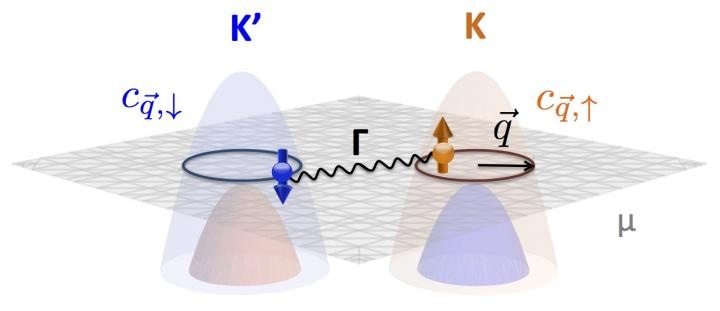Apr 12 2017
 This is a schematic of an interpocket paired state, one of two topological superconducting states proposed in the latest work from the lab of Eun-Ah Kim, associate professor of physics at Cornell University. The material used is a monolayer transition metal dichalcogenide. (Credit: Eun-Ah Kim, Cornell University)
This is a schematic of an interpocket paired state, one of two topological superconducting states proposed in the latest work from the lab of Eun-Ah Kim, associate professor of physics at Cornell University. The material used is a monolayer transition metal dichalcogenide. (Credit: Eun-Ah Kim, Cornell University)
The experimental discovery of ultrathin graphene, for which two Cambridge researchers earned the Nobel Prize in physics in 2010, has redefined materials research.
What initiated with graphene has resulted in the development of a number of related one-atom-thick materials, which exhibit unusual properties because of their ultra-thinness. Transition metal dichalcogenides (TMDs) are one such material with many key features that are unavailable in graphene, making them a potential candidate for next-generation semiconductors.
Topological superconductivity could be realized in TMDs, thus providing a platform for quantum computing – which is the ultimate objective of a Cornell research team headed by Eun-Ah Kim, associate professor of physics.
Our proposal is very realistic - that's why it's exciting. We have a theoretical strategy to materialize a topological superconductor... and that will be a step toward building a quantum computer. The history of superconductivity over the last 100 years has been led by accidental discoveries. We have a proposal that's sitting on firm principles. Instead of hoping for a new material that has the properties you want, let's go after it with insight and design principle.
Eun-Ah Kim
The study results have been reported in an article titled, "Topological superconductivity in monolayer transition metal dichalcogenides," in the Nature Communications journal. The lead author on the paper is Yi-Ting Hsu, a doctoral student in the Kim Group. Kim Group alumni Mark Fischer, now works at ETH Zurich in Switzerland, and Abolhassan Vaezi, now works at Stanford University, are the other members of the research team.
The research team proposes that the unusual properties of TMDs support two topological superconducting states, which, if experimentally proved, will pave the way for controlling topological superconductors at temperatures close to absolute zero.
According to Kim, hole-doped or positive charge-enhanced single-layer TMDs are a potential candidate material for topological superconductivity, due to the existence of special locking between kinetic energy and spin state of electrons (spin-valley locking) of single-layer TMDs and based on the recent studies on superconductivity in electron-doped or negative charge-enhanced single-layer TMDs.
The research team’s objective is a superconductor operating at around 1 degree Kelvin (approximately -457 °F) that could retain quantum computing potential in a superconducting state upon sufficient cooling with liquid helium.
Kim explained that housing a quantum computer robust enough to justify the power required to keep the superconductor at 1 K is theoretically possible. Actually, a 7-qubit (quantum bit) computer operating at below 1 K has been made available to the public by IBM through its IBM Quantum Experience.
Kim informed that a quantum computer with roughly six times more qubits has the potential to fundamentally transform computing.
If you get to 40 qubits, that computing power will exceed any classical computers out there. And to house a 40-qubit [quantum computer] in cryogenic temperature is not that big a deal. It will be a revolution.
Eun-Ah Kim
Kim and her team are working with Katja Nowack of physics, and Debdeep Jena and Grace Xing of electrical and computer engineering, through an interdisciplinary research group seed grant awarded by the Cornell Center for Materials Research. Each team brings researchers from various departments together, with support from the Cornell University and the National Science Foundation's Materials Research Science and Engineering Centers program.
We're combining the engineering expertise of DJ and Grace, and expertise Katja has in mesoscopic systems and superconductors. It requires different expertise to come together to pursue this, and CCMR allows that.
Eun-Ah Kim
The NSF's Platform for the Accelerated Realization, Analysis, and Discovery of Interface Materials (PARADIM) program also provided support to this work.